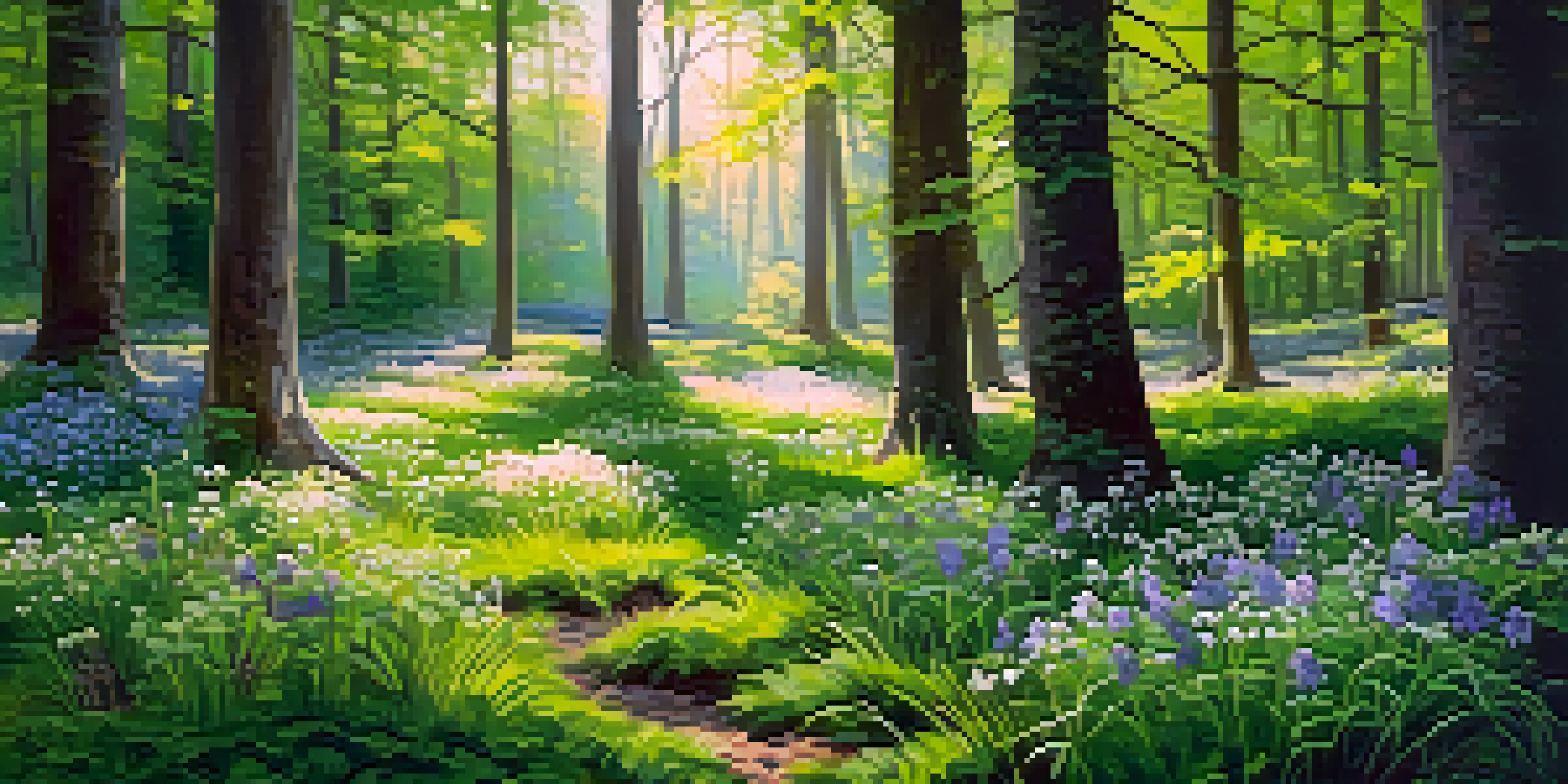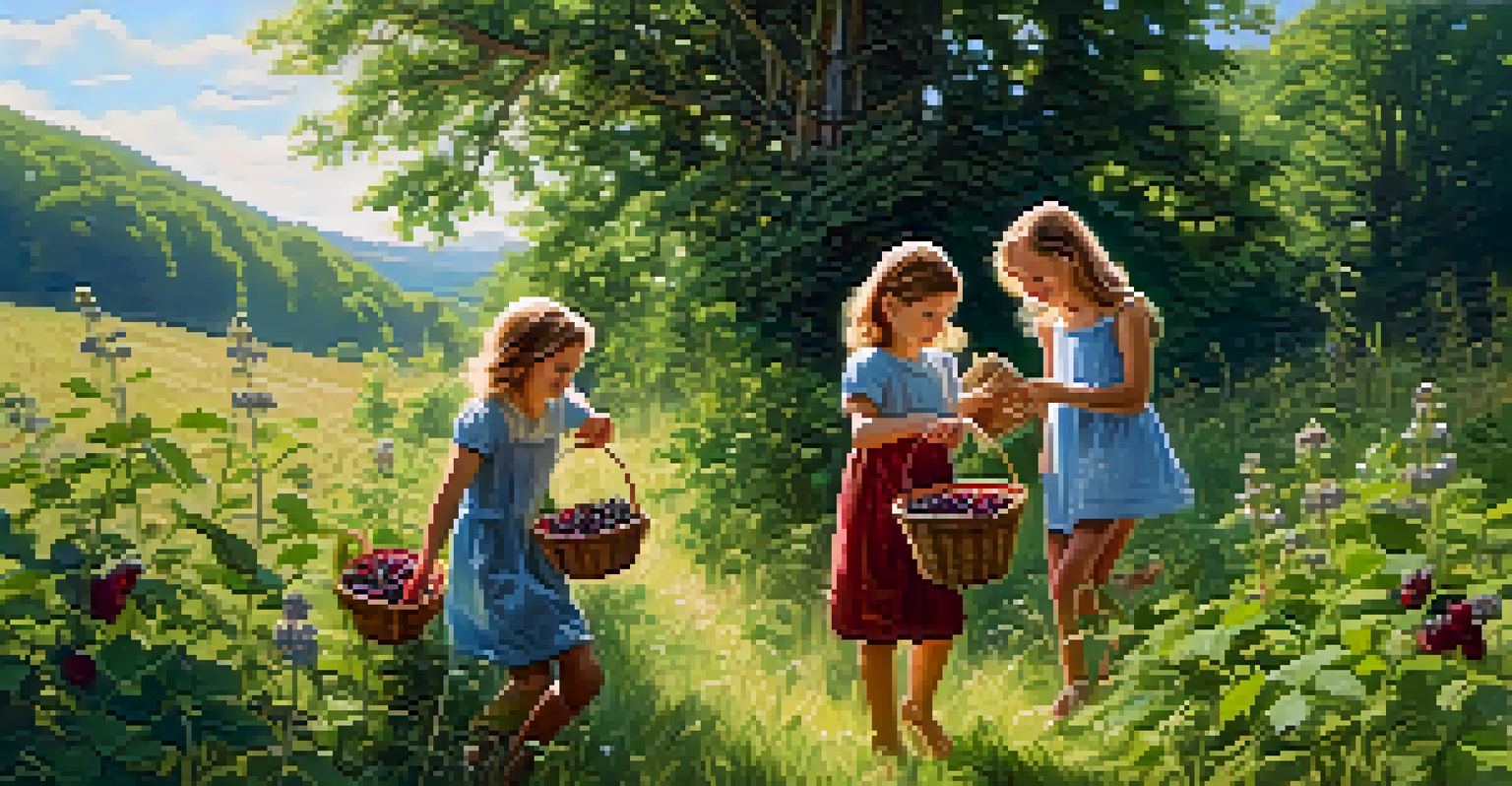Seasonal Foraging: When to Harvest Wild Edible Plants

Understanding Seasonal Foraging and Its Benefits
Seasonal foraging is the practice of gathering wild edible plants based on their natural growth cycles. By aligning your foraging efforts with the seasons, you not only enhance your chances of success but also ensure that you're harvesting at peak freshness. This approach connects you with nature and can lead to a more sustainable lifestyle, as you learn to respect and understand the land.
Foraging is not just a way to find food; it's a way to connect with the land and understand the cycles of nature.
Foraging encourages mindfulness, as it requires you to observe your environment closely. Each season brings a new bounty of flavors and textures, from the tender greens of spring to the hearty roots of winter. By learning when to forage, you can enjoy a diverse range of wild edibles that enrich your diet and culinary experiences.
Moreover, foraging can be a fun and rewarding activity to share with family and friends. Imagine exploring the woods together, discovering new plants, and learning about the ecosystem. It’s an adventure that brings people closer while fostering a greater appreciation for nature.
Spring Foraging: The Season of Renewal
Spring is a vibrant time for foraging, as many wild edible plants begin to sprout after winter’s dormancy. This season is often characterized by tender greens like wild garlic, dandelions, and nettles, which are not only delicious but also packed with nutrients. Early spring is also the time to look for edible flowers, such as violets and elderflowers, which can add a unique touch to your dishes.

As the weather warms, you’ll find a variety of mushrooms emerging, such as morels, known for their distinctive honeycomb appearance and rich flavor. It’s essential to ensure you can accurately identify these mushrooms, as some can be toxic. Joining a local foraging group or taking a guided tour can help you gain confidence in your foraging skills.
Seasonal Foraging Enhances Freshness
Aligning your foraging efforts with the seasons allows you to harvest wild edibles at their peak freshness and promotes a sustainable lifestyle.
Remember, foraging in spring is not just about gathering food; it's a celebration of nature's rebirth. Take the time to appreciate the beauty of blooming flowers and the sounds of wildlife awakening, making your foraging adventure a holistic experience.
Summer Foraging: A Bounty of Flavors
Summer is often deemed the peak season for foraging, boasting a wide array of edible plants and fruits. From juicy blackberries to tart wild plums, the summer months are an abundant time for those willing to explore. Many leafy greens, such as purslane and lamb’s quarters, can also be found, offering a fresh addition to salads and dishes.
In every walk with nature one receives far more than he seeks.
This season is perfect for foraging herbs like mint, thyme, and dill, which can elevate your culinary creations. When foraging in warmer months, be sure to harvest in the early morning or late afternoon to avoid the heat and ensure the best flavor. Additionally, consider the ecosystem; sustainable foraging practices involve taking only what you need and leaving enough for wildlife.
Summer foraging can also be an engaging activity for kids and families. It’s a fantastic opportunity to teach children about nature, responsibility, and nutrition while creating lasting memories together. Plus, who wouldn’t love a homemade blackberry pie made from freshly foraged berries?
Autumn Foraging: Nature’s Harvest Time
Autumn is a time of abundance, as many wild plants have matured and are ready for harvest. This season is ideal for gathering nuts like acorns and chestnuts, which can be used in various recipes or enjoyed as snacks. Additionally, wild fruits such as apples and berries can be found, adding natural sweetness to your pantry.
Mushrooms continue to thrive in the cooler temperatures of autumn, with varieties like chanterelles and shiitakes becoming available. However, with great variety comes the need for caution; always ensure you correctly identify mushrooms before consuming them. It’s a good time to revisit foraging guides or consult with experienced foragers to enhance your skills.
Autumn Offers Abundant Harvests
Autumn is a prime time for gathering mature wild plants, nuts, and mushrooms, making it a rewarding season for foragers.
As you forage in autumn, take time to reflect on the changing landscape. The vibrant colors of the leaves and the crisp air create a magical backdrop for your adventures. Gathering food during this season can feel like a celebration of nature's generosity, making it a rewarding experience.
Winter Foraging: Finding Hidden Treasures
Many might think foraging is off the table in winter, but there are still edible treasures to discover. Certain hardy greens like chickweed and wintercress can be found poking through the snow, offering a fresh taste even in the cold months. Additionally, roots such as burdock and dandelion are still available for harvesting, providing nutritious options for winter meals.
Winter is also a prime time for harvesting tree barks and inner shoots, which can be used for teas or as flavoring agents. For example, the inner bark of the slippery elm tree is not only edible but also has medicinal properties. Understanding the plants that thrive in winter can expand your foraging knowledge significantly.
Foraging in winter can be a serene and quiet experience, allowing you to connect with nature in a different way. The stillness of the landscape invites contemplation, making it a perfect time for reflection and planning your foraging adventures for the upcoming spring.
Essential Safety Tips for Foragers
Safety should always be a top priority when foraging for wild edibles. One of the most critical rules is to positively identify any plant before consuming it. Many edible plants have poisonous look-alikes, so it’s essential to use reliable foraging guides or apps and, if possible, consult with an expert to confirm your findings.
Additionally, be mindful of the environment from which you’re foraging. Avoid areas that may have been treated with pesticides, herbicides, or other chemicals, as these can contaminate the plants. Always forage in clean, safe areas, and consider the regulations regarding foraging in public spaces.
Safety is Crucial When Foraging
Identifying plants accurately and foraging sustainably are essential practices to ensure safety and respect for the environment.
Lastly, practice sustainable foraging by taking only what you need and leaving enough for wildlife and future growth. By respecting nature and its cycles, you contribute to a sustainable ecosystem. Remember, foraging is not just about gathering food; it's about fostering a relationship with the environment.
How to Prepare and Enjoy Your Foraged Finds
Once you’ve gathered your wild edibles, the next step is to get creative in the kitchen. Many foraged plants can be used in traditional recipes, while others can inspire new culinary adventures. For instance, wild greens can be sautéed, added to soups, or used in salads, while berries make for delicious jams and desserts.
It’s also important to experiment with flavors and textures when cooking with foraged ingredients. Consider pairing wild garlic with roasted vegetables or using elderflowers to create refreshing cordials. The unique flavors of wild edibles can elevate your meals and introduce you to new taste sensations.

Lastly, share your foraged dishes with friends and family to spread the joy of seasonal eating. Not only does this practice create community, but it also encourages others to explore foraging as a fun and sustainable activity. By celebrating your culinary creations, you help foster a deeper connection to the food you consume.
Resources for Aspiring Foragers
If you're excited to dive into the world of foraging, there are plenty of resources available to help guide your journey. Start with local foraging books that focus on your region, as they'll provide valuable insights into the plants that grow near you. Online forums and social media groups can also connect you with fellow foragers for tips and advice.
Consider attending workshops or guided foraging tours offered by local experts. These experiences can significantly enhance your understanding of wild edibles, as you'll learn firsthand about plant identification, sustainable harvesting, and preparation techniques. Plus, it’s a great way to meet others who share your interests.
Lastly, don’t forget to keep a foraging journal to document your findings and experiences. Tracking what you’ve discovered and the recipes you’ve created can serve as a valuable resource for future foraging adventures. With the right tools and knowledge, you’ll be well on your way to becoming a seasoned forager.